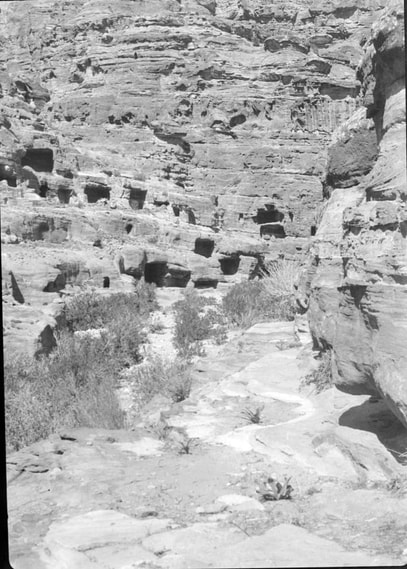|
[possibly by Agnes Conway]
Mr Horsfield went to Maar [sic] to get money and started packing pottery. AEC went to Zibb Atuf and got the larger cistern dug out. She brought back all the fragments of pottery, which include most of the types from Byzantine to Nabataen and Greco-Roman already found here. She then dug a square yard in front of the small cistern to see whether there was an artificial channel for the liquids from the round altar. A wall 50 centimetres thick was found running at right angles from the corner of the cistern to the natural stone. Immediately in front of the cistern, at the 40 cm level, a stratum of burning was struck, full of burnt pottery, which Mr H declared to be Nabataean. The outflow of the liquid must have been stopped by the wall, one stone of which is still in position standing above the ground. She went down by the S. way to the Wady En Mer and the Hrabet-en-Mer, where the Obodat inscription is. This shrine to the Divine Obodat, if it is one, looks exactly like a house. What Dalman calls a statue and which should probably be translated “image” is clearly an omphalos in a niche; the spot above it, said by Dalman to be the hollow for the upper part of the statue, being the last remains of the fine tooling of the niche above the omphalos. The stone on which the inscription is, occupies the position of a 9 inch vertical beam in relation to the ceiling, and covers two yards to the front of the niche. The beam, squared and tooled its whole length where it is not inscribed, as well as on the bottom face, has apparently been broken off to the left of the inscription, and forms an integral part of the ceiling, which, elsewhere, is extremely roughly tooled. The walls are delicately tooled and squared. The omphalos looks like the Dushara symbol commonly employed at Bostra on the coins. If so, the Divine Obedat was worshipped as Dushara. Does the inscription imply that it was put up by a private family in their private house? That is what it looks like. Photographed the Stibadium house above the Siyagh and finished planning the excavated Siyagh house. Reference: [unsigned, possibly Conway, A.] 1929 (transcribed by A. Thornton). Petra Exploration Fund Diary. "Business Papers to be Kept", Horsfield Collection Box 8, UCL Institute of Archaeology, 8 May: 71-72. [By Agnes Conway and George Horsfield]  A street in Siyagh, opposite El Habis, photographed in 1929. Copyright UCL Institute of Archaeology. A street in Siyagh, opposite El Habis, photographed in 1929. Copyright UCL Institute of Archaeology. A. C. Went with Mr Horsfield to the opening of four graves in a round arched tomb chamber on El Habis – untouched; and photographed the skeletons. The last day’s dig, and all the men were paid off in the afternoon. Photographed and planned the three storied house in the Siyagh. G. H.
Opened the four graves in the North Tomb at El Habis. The first lies across the threshold and was covered with flagstones. The others were roughly coffin shaped and were filled in with gravel from Wadi bed. Began on the one nearest to wall inside, which contained nothing but the remains of a skull and some fragment – it was dissected by [blank] but it had never been disturbed. The next was much the same, but produced a few more bones, likewise next. They were all the same in type and equally barren in objects. The Threshold grave was more interesting – it was much wider and square ended – on removing cover saw it was broken through into tomb under. There were two skeletons side by side, the upper part of right hand was gone, having fallen through hole and the other partly. The grave was full of sand which seemed to have been washed in. On dissection 11 skulls turned up, and underneath top skeletons was a mass of disordered bones and skulls. It had been used as a charnel house, but the last burials were orderly and the cover was sealed with lime mortar. There was not the slightest indication of the age of graves – about 1.00 m above floor on the sand were found a number of pots. The doorway has a certain architectural character but is crude and poorly executed. Not a thing was found on floor level or in the graves. The orientation was E & W. The dead were laid with their feet to the E. Reference: Conway, A. and Horsfield G. 1929 (transcribed by A. Thornton). Petra Exploration Fund Diary. "Business Papers to be Kept", Horsfield Collection Box 8, UCL Institute of Archaeology, 9 May: 72-74. [possibly by Agnes Conway]
A.E.C. rode with Mr Horsfield to Al Khan and the Birka and climbed up to the castle of El Wejra from the West, in the morning. Photographed the large triclinium house in the Hadrianic suburb in the afternoon. Reference: [unsigned, possibly Conway, A.] 1929 (transcribed by A. Thornton). Petra Exploration Fund Diary. "Business Papers to be Kept", Horsfield Collection Box 8, UCL Institute of Archaeology, 11 May Part 1: 74. |
Categories
All
Archives |
 RSS Feed
RSS Feed